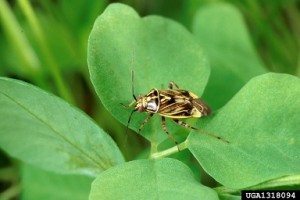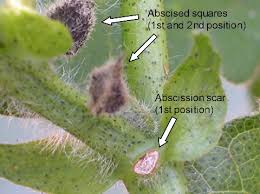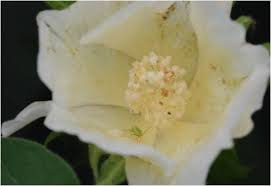

During the last few weeks, I’ve had several questions and calls concerning Tarnished Plant Bugs. The plant bug builds it’s population in alternate hosts, such as ditches, edge of woods, etc… In general, bug numbers are up so we should be aware of their potential presence in cotton. The increased number is most likely due to the wet spring we experienced. The 2014 spring weather provided favorable conditions for alternate hosts to grow well and remain green therefore supporting plant bug populations. Whenever these host spots begin to dry down, the plant bug moves to new locations, seeking something green to feed on. This insect is considered a sporadic pest in cotton but does require scouting and monitoring of square retention. Dr. Phillip Roberts (UGA entomologist) reports that there are fields being treated for plant bugs this season and we should maintain careful scouting procedures for this pest. Although plant bugs are an uncommon pest, if we fail to detect them economic infestations can result in yield loss and delays in maturity. Adult Tarnished Plant Bug and immature Tarnished Plant Bug are potential economic problems in cotton production.
 Plant bugs prefer to feed on small squares but they can feed on large squares too. Plant bugs have a needle mouth part that they insert into small squares. After piercing the square, the plant bug injects toxins to dissolve the plant tissue and then sucks the tissue out of the structure. The plant will recognize the damage and begin the process of shedding, ultimately aborting the position. The toxins cause the square to become discolored, changing in color from off green, to yellow, brown, and black. Within a couple of days, the square is eventually shed by the plant. When monitoring square retention, look at small squares in the top of cotton (or where square should be located) and calculate percentage of healthy squares. UGA recommends that we should have a goal of retaining at least 80% of all first position squares at first bloom. Treatment is required when we have less than 80% retention of pinhead squares and are observing numerous plant bugs in the field.
Plant bugs prefer to feed on small squares but they can feed on large squares too. Plant bugs have a needle mouth part that they insert into small squares. After piercing the square, the plant bug injects toxins to dissolve the plant tissue and then sucks the tissue out of the structure. The plant will recognize the damage and begin the process of shedding, ultimately aborting the position. The toxins cause the square to become discolored, changing in color from off green, to yellow, brown, and black. Within a couple of days, the square is eventually shed by the plant. When monitoring square retention, look at small squares in the top of cotton (or where square should be located) and calculate percentage of healthy squares. UGA recommends that we should have a goal of retaining at least 80% of all first position squares at first bloom. Treatment is required when we have less than 80% retention of pinhead squares and are observing numerous plant bugs in the field.
If the plant is missing a position square, it is possible to see a scar. Observation of plant scars is one way to assess plant bug presence. Also, additional signs of plant bug damage includes, squares that are loosely attached to plant and drop easily when touched. Healthy, undamaged squares will be firmly attached to the cotton plant. It is important to remember that prior to bloom it is rare for a cotton plant to shed small squares. Occasionally, we may see some shedding due to aggressive tillage that has pruned roots in cultivated cotton or if post herbicide applications has resulted in severe plant injury. But, in the absence of stress factors such as these, most square shedding can be contributed to plant bugs.

An additional sign of plant bug feeding can be dirty blooms (dirty marking on petals). Dirty blooms result when a plant bug was feeding on a large square that wasn’t shed by the plant.
Overall, plant bugs are very elusive in cotton (especially adults) and scouting for this pest will require careful attention to all of the listed symptoms of plant bug infestations.
Dr. Roberts has indicated that currently, most fields with plant bug issues are earlier planted cotton fields that have reached the 10-12 node growth stage. We should only treat fields if it is absolutely necessary because of the increased risk for other problems, such as spider mites. The standard treatment option is Acephate (Orthene) which provides excellent control of plant bugs but increases the risk of aphids and spider mite outbreaks. Other insecticide options, with very good activity on plant bugs and aphids, includes Centric and Transform. Admire Pro offers fair control of plant bugs and aphids. It is very important to remember that we are not allowed to apply Bidrin to squaring cotton. We can apply Bidrin for thrips on cotton during seedling stage but can’t apply Bidrin again until cotton begins to bloom. The Bidrin label prohibits application during squaring and only allows applications after first bloom. All insecticide applications for plant bugs should only be applied when needed. If we can retain 80% of first position squares at first bloom we are maintaining maximum yield potential.
